smooths out your shakes, but adds one of its own…
© 2011 by KV5R — Rev. June 20, 2011.
Shop for Camera Stabilizers here.
Introduction
Better in 480p, fullscreen…
Be sure to read the next article, where I improve this deisgn.
I built this one for my particular camera. If you build according to these plans, you’ll need to modify it until it works for your camera. I would guess the materials and dimensions given can be tuned for cameras weighing from 0.4 to 1.0 pounds by adjusting the bends, the C.G. and adding some weight (a few flat washers) here-n-there. But if you have a ≈½-pound pocket camera, this will get you in the ballpark, and if you balance and tune it right, it will perform as well as the commercial ones. It isn’t aerodynamically balanced, so will not perform well for high-speed or windy activities, but should be fine for the casual stroll through the car show or kid’s party.
Notes
This project will cost around $30 in parts, and take two or three afternoons to build and tune. Don’t expect professional results right away—running any camera stabilizer requires practice.
A good source for threaded hardware, aluminum, and all-thread is Tractor Supply Co. (TSC). They sell nuts/bolts/washers by the pound, so you can get a bag-full for just $2-6. Try to go all stainless if you can—it’s a lot prettier than the zinc-plated stuff. Ace Hardware has a better selection, but they sell by the each. Look there for things like springs and setscrews.
Don’t make the mistake I did of spray-painting the aluminum—the regular spray-can enamel is not suitable. Painting aluminum properly is at least a three-step process. You might want to go to a good paint shop and get some mild etch (Alumiprep), zinc chromate (Alodine), and polyurethane paint. If cost isn’t a factor, you can send the parts out for anodizing and dyeing. Be sure to finish and polish the parts first.
Search for the toy giblets from online stores with free shipping—never reward merchants that sell you a 99 cent part and charge $9.99 S/H and then mail it to you for 85 cents. What a rip-off!
The type 608 (8x22x7mm) bearings will pass a 5/16ths″ (or 8mm) bolt, while the type 627 (7x22x7mm) will pass a ¼″ (or 7mm) bolt. Both will press-fit into heated ¾″ schedule 40 PVC pipe (.824″ nominal I.D.; the 22mm bearings are .866″ O.D.). They will also press into heated ½″ sch. 40 PVC fittings (.840″ I.D.). Get grade ABEC-5 or -7 bearings, with shields but not seals. Here’s a good FAQ about bearings, and here’s another FAQ about bearings.
The bottom of the frame will need a little weight—I used 56 grams—and that weight will need to be a little behind the camera to achieve dynamic balance. I tried weight on the front curve, but that just made the bottom weight need to be further aft, where it runs into your body.
For weights, you will need a selection of flat washers, typically some 3/8, 5/16, and 1/4. But be aware that they come in different thicknesses, so use a digital gram scale and sort your washers by weight, not size. Fender washers may be drilled off-center so you have eccentric weights, which are easier to fine-tune the balance.
The Traxxas 5151 female splined half-shafts will accept force-threaded 5/16ths hardware. If you file the top slot 5/16ths wide, you can thread the upper half-shaft half-way onto a 5/16ths × 1½ bolt, and thus finely adjust the drop-time, which should be between 1 and 2 seconds. If you want to use ¼″, you’ll need to mold ¼-20 threads into the female half-shafts (with epoxy), or you can tap the male half-shafts for ¼-20, cut them off their yokes, and glue them into the female half-shafts.
Tools Needed
- Table saw or power-miter saw (with carbide blade)
- Table router (with straight ¼″ 2-flute router bit or end mill)
- Small drill press (with vise and drill bits)
- Bench grinder with grit and wire wheels (or at least a mill file)
- Bench vise
- Hacksaw (with 32T blade)
- ¼-20 Bottom Tap (with T-handle), if tapping the male half-shafts
- The usual assortment of hand tools (wrenches, hammer, punch, stick rule, etc)
Use the table (or miter) saw for cutting the aluminum and PVC nice-n-straight. Use the hacksaw for trimming bolts and all-thread.
WARNING: Always wear safety goggles when cutting or grinding! And beware of hot flying bits of metal.
Materials
- 1/8th × 1 × 48″ aluminum flatstock (≈$8 at most hardware stores) Note: too thin — use ¼″ instead. If you get 6061-T6 note that it doesn’t like to be bent, and it will crack if you bend it sharply. Use a softer aluminum, or keep the bend radius in 6061 greater than 6 times it’s thickness.
- Traxxas 5151 U-joint (called “half-shafts”) (≈$8.50 at eBay shops)
- Type 608 skateboard or 627 roller skate bearings, shielded, not sealed, (≈$6-8 for a set of 8 at eBay shops).
- 5/16ths-18 (if 608), or ¼-20 (if 627) × 12″ all-thread rod
- 5 inches of ¾″ schedule 40 PVC pipe (handle)
- Sundry 5/16ths and/or ¼″ hardware (carriage bolts, capscrews, flatwashers, fender washers, lockwashers, nuts, wingnuts, etc.)
- A dozen or so 5/16ths and/or 3/8ths″ flatwashers (weights)
- Epoxy (≈$4 at Walmart paint dep’t, double syringe-type with mixer). You can eliminate this by using 5/16ths all-thread in the handle assembly.
Building It

You can build your own table saw and table router…

…like this. Drill and tap the baseplate of the saw and router for 10-24 machine screws.
I added a double-gang electrical box, with 2 switch-plugs. Also a solid-state speed controller.
The fence is 2x2 aluminum angle, held with c-clamps. You must measure carefully at
both ends to make sure the fence is clamped parallel to the saw blade.
Any freestanding ½–¾″ plywood work table will do, as long as it’s stable.
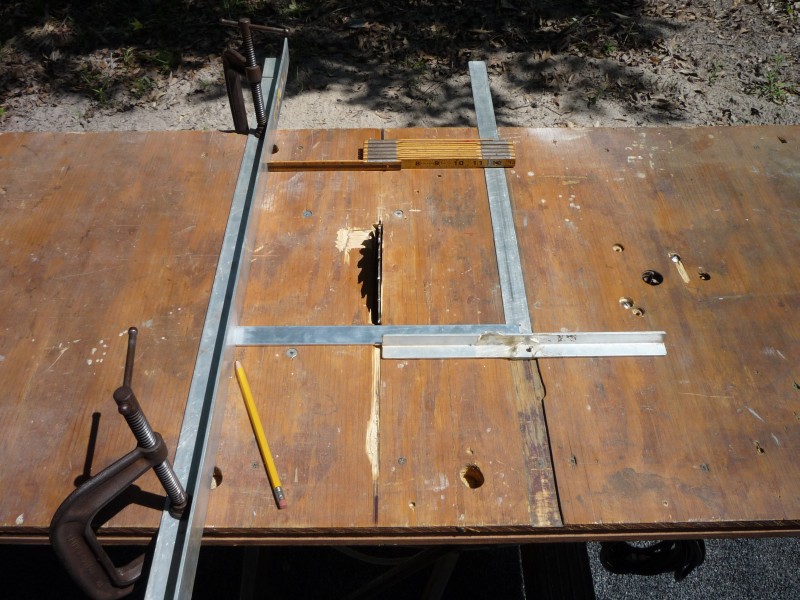
Cut (3) 6″ pieces of aluminum, leaving one 30″ piece.

Take (2) 6″ pieces, and the 30″ piece, and mark…

and punch…

and drill ¼″ holes. (The third 6″ piece is scrap.)

Make a mark where you want the slot in the 30″ piece to stop (5 inches of slot).

Now route a 5″ long slot in the two 6″ pieces, and one end of the 30″ piece.
You’ll need to set up 2 fences as shown. Note: use a 2-flute router bit or end mill.

It gets HOT! Push with a screwdriver and hold down with a gloved finger. Go slowly.
Use safety glasses! Sharp bits of aluminum fly everywhere.
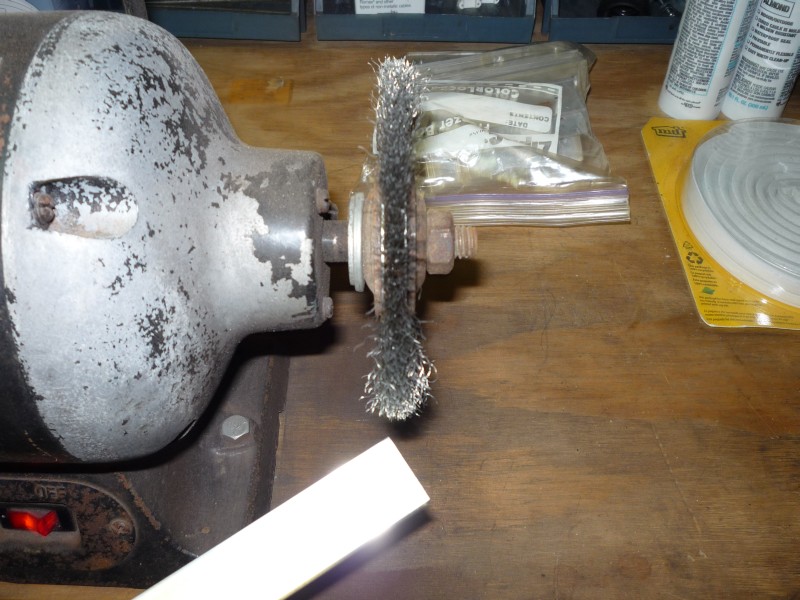
De-burr all six ends.

File all 3 slots.

Mark 6 inches on the 30″ piece. This will be your first bend.
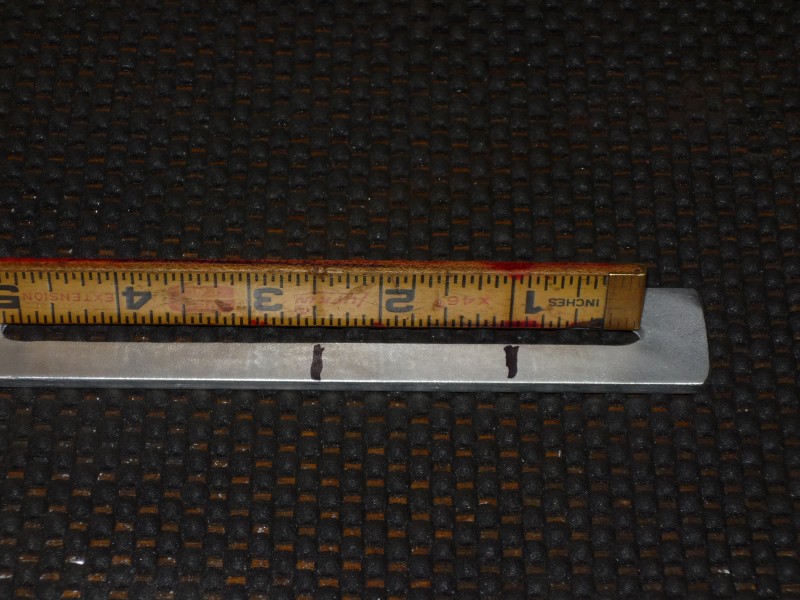
Take one 6″ piece and mark at 1″ and 2½″ from one end of the slot.

Bend on the two marks like this…

…and finish like this…

…to end up with this. The camera will mount on top, the stabilizer on the bottom.
This is your side-balance adjustment bracket. Pocket cameras have the mounting
hole way off (mine is 1-3/8″es off) from the camera’s center of gravity.
This also allows you to change the batteries without removing the camera.
Not shown: Put the 30″ piece in the vise at the 6″ mark and bend it 30 degrees.

Now find something about 6-8″ in diameter you can clamp down and bend around.
Go 120 degrees. Hold it at the 6″ mark and at 16 inches. Don’t bend the slotted part.

Mount the bracket…

…and the camera, so you can start forming the leg for balance.

You want a shape sorta like this. Back to front is about 9 inches, and top to bottom is
about 19 inches. The bottom weight needs to be a little behind the camera’s C.G.

A little keychain level (some hardware store check-outs) can be drilled for a tiny screw.
The 6″ slotted piece goes across the top slot; it’s the fine balance trim.

Go ahead and make a dummy camera, so you don’t bang up the real one.

Use a digital scale to make it the same weight, and drill a 7/32nds hole in the
bottom, offset the same distance as the camera’s mounting hole offset.

If your top slot will pass a 5/16ths×1½ bolt, force-thread the longer half-shaft onto it about
half-way. This will be your fine drop-time adjustment. To use ¼-20, prep it like the lower one.
You can eliminate the steps in the next 5 photos simply by using 5/16ths all-thread for the handle assembly.

Cut and de-burr 5 inches of all-thread. The double-nutted fender washer will be your panning ring.
You can wrap just the right amount of tape around it and force it into the half-shaft, OR…

…grease the threads, run a nut over them to distribute the grease evenly, and…

…fill the half-shaft(s) with silicone caulk… (doesn’t work—use epoxy)

…then push the stud in slowly so it doesn’t run over, but the excess squirts out the
little hole in the half-shaft (have waste can under it). Trim off the tail with a small screwdriver.

Line it up nice and pretty. Now leave it alone for 24 hours. Thanks to
the grease, you should be able to adjust or remove the stud if needed.
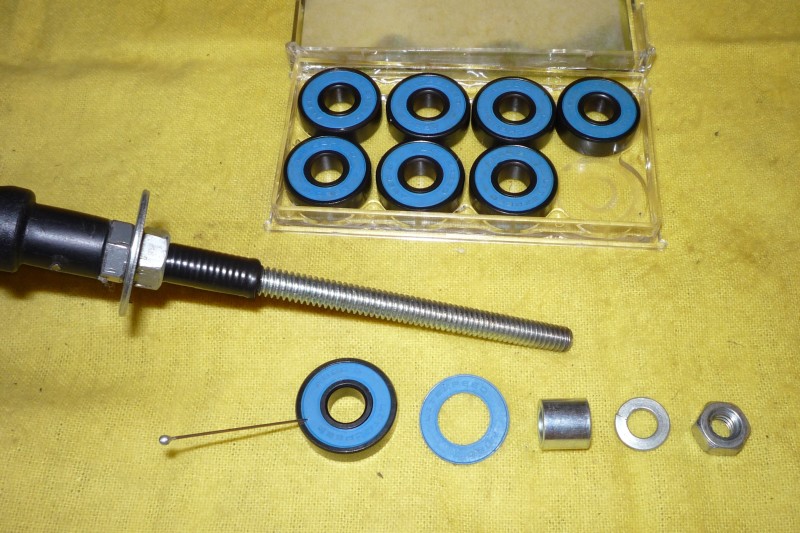
The bearing grease makes too much friction; it should be dry or have a bit of very light oil.
Remove the seal with a pin, wash out grease with carb cleaner, blow with air compressor…

Put sewing thread in u-joint, if needed, to take up any slack between the yokes and the ball.

Here’s the 2-bearing assembly. I should’ve used 5/16ths all-thread here.

Heat one end of the PVC handle until it’s flexible, then push it over the bearing assembly.

parts layout

bottom weight

top dimensions
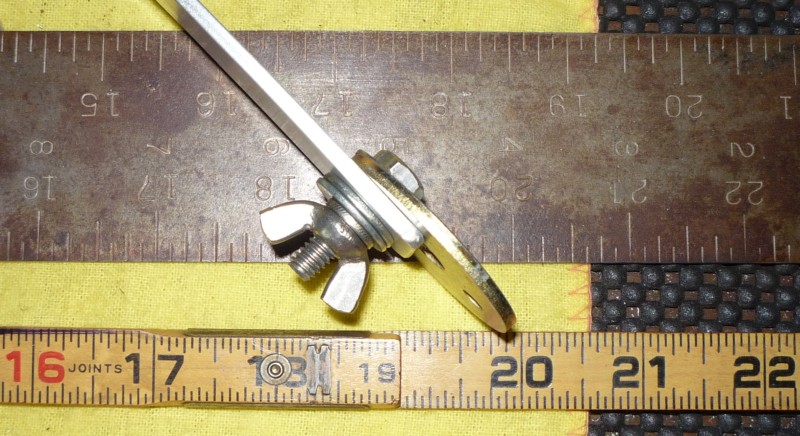
bottom dimensions

front dimensions

Cool dawg…
So there you have it! My first camera stabilizer experiment.
What Went Wrong
- I expected, based on some Youtube videos, that (1) the Traxxas U-joint would force-thread onto ¼″ hardware, and (2) that the skateboard bearings were also ¼″ I.D. Nope—both need 5/16ths (or 8mm) all-thread, and I didn’t have any handy. Using 5/16ths in the handle assembly would have been a lot easier.
- Cutting the slots with the router worked, but it was a little sloppy, caused by the vibration of the high-speed router. Instead, put the router bit in a drill press and turn it slowly, sliding the work-piece between the drill press vise jaws, or better, use a cross-slide vise, or even better, a real milling machine.
- The 1/8th″ aluminum is too thin. It wiggles and jiggles, as you see in the video. Use ¼″ aluminum instead.
- The whole thing ended up a lot larger than I expected. For a camera this small and light, the whole rig could be quite a bit smaller, with the minimum being the swing clearance of the handle.
- Don’t paint it. You see above how my paint got scratched up right away. I ended up removing it all with mineral spirits (paint thinner).
Stay Tuned!
Next, I rebuild the stabilizer and remove the wiggle.
—KV5R
